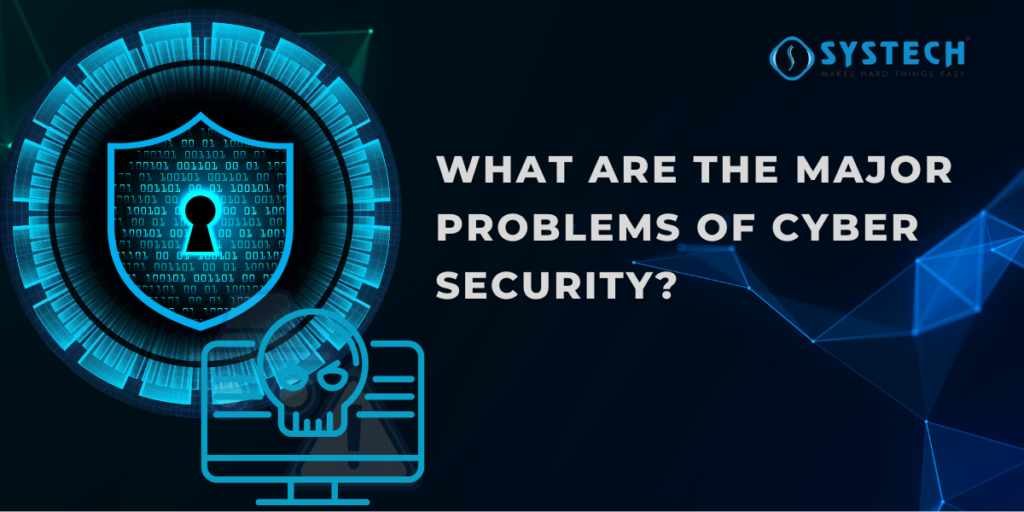Table of Contents
What Are the Major Problems of Cyber Security?
Introduction
In today’s interconnected digital environment, cyber threats have become more sophisticated, targeting vulnerabilities in systems, networks, and human behaviour. From major cyber security attacks like ransomware to challenges such as weak password policies, these issues pose significant risks to businesses, governments, and individuals. Understanding these challenges is crucial for building robust defences and safeguarding critical data.
Key Takeaway
Cybersecurity challenges are evolving rapidly. Addressing these problems requires a multi-faceted approach that includes strengthening technical measures, raising awareness, and investing in cutting-edge solutions. This blog offers insights into the biggest issues in cybersecurity and how to mitigate them effectively.
Understanding the Major Security Problems in CyberSecurity
The major security problems in cyber security arise due to the dynamic nature of technology and the increasing dependence on digital platforms. Organizations in India face growing risks from cyberattacks, often amplified by outdated systems, insufficient budgets, and lack of employee awareness. Tackling these problems requires proactive strategies, regular assessments, and robust security frameworks.
Why Are Cyber Security Problems Increasing Globally?
Cybersecurity problems are rising due to the rapid digitization of services and the widespread adoption of remote work. Factors such as inadequate security measures, unpatched vulnerabilities, and problems of cyber security awareness among users contribute significantly. Additionally, attackers are leveraging advanced technologies like AI to launch sophisticated attacks.
The Importance of Tackling Major Security Issues in 2025
As we move further into 2025, addressing major problems in cyber security has become more critical than ever. With increasing cases of major cyber security attacks, organizations must adopt comprehensive strategies to safeguard their systems. Ignoring these challenges can lead to reputational damage, financial losses, and long-term operational disruptions.
Major Cyber Security Attacks and Their Impact
The consequences of cyberattacks can be devastating, ranging from compromised customer data to significant downtime in critical services. Major security problems in cyber security often stem from high-profile attacks like ransomware, DDoS, and phishing, which exploit system vulnerabilities and human errors. Understanding these attacks is the first step toward effective mitigation.
The Rise of Ransomware Attacks
Ransomware attacks have emerged as one of the biggest issues in cybersecurity globally. Attackers encrypt critical data and demand a ransom for its release. This not only disrupts business continuity but also poses financial challenges, particularly for small and medium enterprises in India.
Data Breaches: The Cost of Compromised Information
Data breaches compromise sensitive information, affecting both organizations and individuals. Such incidents often result from weak security systems or insider threats, making it essential for businesses to strengthen their defences against this problem of cyber security.
Distributed Denial of Service (DDoS) Attacks Explained
DDoS attacks overwhelm systems by flooding them with traffic, rendering services inaccessible. These attacks can cripple online platforms and lead to significant downtime, highlighting the importance of addressing this major security problem in cyber security.
Phishing and Social Engineering: A Persistent Threat
Phishing attacks deceive users into revealing sensitive information, often through fake emails or websites. These attacks rely on human error, making awareness programs vital to counter this growing problem of cyber security.
Zero-Day Exploits: Why They Are So Dangerous
Zero-day exploits target unknown vulnerabilities, leaving no time for organizations to respond. These sophisticated attacks pose a severe risk, as they can bypass even the most advanced security systems, becoming a significant concern in major cyber security attacks.
Identifying the Biggest Issues in Cybersecurity Today
The biggest issues in cybersecurity today stem from a mix of technical challenges, user behaviour, and resource constraints. Organizations need to address these vulnerabilities to build a resilient digital infrastructure. Understanding these issues is key to prioritizing efforts and implementing targeted solutions.
Weak Password Policies and User Negligence
Weak passwords and careless user behavior remain a persistent problem of cyber security. Many users still rely on simple, easily guessed passwords, exposing systems to brute-force attacks. Organizations must enforce strong password policies and encourage the use of multi-factor authentication.
Lack of Employee Awareness About Cyber Threats
Employee negligence often leads to security breaches. Without proper training on recognizing phishing attempts or handling sensitive data, employees become the weakest link in the chain. Regular awareness programs can significantly reduce this major security problem in cybersecurity.
Outdated Security Systems and Software
Failing to update software and systems can leave organizations vulnerable to exploitation. Cybercriminals target known vulnerabilities in outdated systems, emphasizing the importance of regular updates and patch management to counter this problem of cyber security.
The Challenge of Securing Remote Work Environments
With the rise of remote work, securing home networks and personal devices has become a significant challenge. This trend has expanded the attack surface, making it difficult for organizations to maintain control over their security protocols.
Insufficient Cybersecurity Budgets in Organizations
Many organizations, particularly in India, allocate inadequate budgets for cybersecurity. This leaves them ill-equipped to handle emerging threats, making it crucial to prioritize cybersecurity investments to mitigate major problems in cybersecurity.
Major Problems in Cyber Security: The Technical Challenges
Technical challenges in cybersecurity are often the most difficult to address due to their complexity and evolving nature. From securing IoT devices to managing advanced threats, these issues require innovative solutions and proactive monitoring.
Vulnerabilities in Internet of Things (IoT) Devices
IoT devices, while convenient, often lack robust security measures. This makes them easy targets for attackers, leading to risks such as unauthorized access and data theft. Addressing IoT vulnerabilities is a critical step in resolving major security problems in cybersecurity.
Artificial Intelligence and Machine Learning in Cyber Attacks
While AI is used for defence, attackers are also leveraging it to automate and enhance their methods. AI-driven cyberattacks are faster, more sophisticated, and harder to detect, posing a significant problem of cyber security for organizations worldwide.
Cloud Security Issues: Protecting Sensitive Data in the Cloud
As more businesses move to the cloud, ensuring the security of sensitive data has become a pressing issue. Misconfigurations, unauthorized access, and data breaches are common concerns, emphasizing the need for robust cloud security measures.
Malware Evolution: Adapting to Advanced Threats
Malware is constantly evolving, becoming harder to detect and remove. Advanced forms like fileless malware exploit vulnerabilities without leaving traces, making them a major problem in cyber security that demands advanced detection tools.
Cryptojacking: The Hidden Cybersecurity Issue
Cryptojacking, where attackers use compromised systems to mine cryptocurrency, is a growing yet often overlooked threat. It impacts system performance and energy consumption, adding another layer to the biggest issues in cybersecurity today.
Problem of Cyber Security in India: A Local Perspective
India faces unique cybersecurity challenges due to its rapidly growing digital economy and diverse organizational landscape. Addressing these issues requires a combination of education, regulation, and investment in infrastructure.
Lack of Awareness Among Small and Medium Enterprises (SMEs)
SMEs in India often lack the resources and knowledge to implement effective cybersecurity measures. This makes them easy targets for cybercriminals and highlights the need for tailored solutions for smaller organizations.
The Role of Government Policies and Data Privacy Regulations
The Indian government has introduced several initiatives to address the problem of cyber security, including data protection laws and awareness campaigns. However, stricter enforcement and widespread adoption of these policies are necessary to make a significant impact.
Notable Cyber Security Incidents in India
India has witnessed several high-profile cyberattacks, including data breaches and ransomware attacks on large corporations. Analyzing these incidents helps in understanding vulnerabilities and improving preparedness against future threats.
How to Address the Major Security Problems in CyberSecurity
Mitigating major security problems in cybersecurity requires a combination of technical solutions, employee training, and strategic partnerships. Proactive measures can significantly reduce risks and strengthen overall resilience.
Investing in Cybersecurity Training and Awareness Programs
Education is one of the most effective ways to combat cyber threats. Regular training programs for employees can reduce the risk of human error and help organizations tackle the biggest issues in cybersecurity effectively.
Leveraging Advanced Tools for Threat Detection and Response
Using cutting-edge tools like SIEM (Security Information and Event Management) and endpoint detection systems allows organizations to monitor and respond to threats in real time, reducing the impact of attacks.
Partnering with Cybersecurity Experts for Proactive Solutions
Collaborating with cybersecurity experts ensures access to specialized knowledge and tailored solutions. This proactive approach is vital for addressing major problems in cyber security efficiently.
The Role of AI and Automation in Strengthening Security
AI-powered security tools can analyze vast amounts of data to detect anomalies and predict potential threats. Automation streamlines responses, allowing organizations to address issues before they escalate.
Conclusion :
Cybersecurity is a vital necessity in today’s digital world. Addressing challenges like human errors, technical vulnerabilities, and budget constraints requires collective efforts and proactive measures. In India, stronger policies, awareness, and robust frameworks are essential to safeguard the growing digital ecosystem. Prioritizing cybersecurity ensures safer environments for businesses and individuals alike.
Related Courses
FAQs
How does cryptojacking impact businesses and individuals?
Cryptojacking drains system resources to mine cryptocurrency without the owner’s consent. For businesses, this can slow down operations, increase electricity costs, and damage hardware over time. Using endpoint protection tools and monitoring resource usage helps detect and prevent such attacks.
Why do outdated systems pose a significant cybersecurity threat?
Outdated systems are vulnerable because they lack the latest security patches, making them easy targets for cybercriminals. Attackers can exploit known vulnerabilities in older software versions, leading to data breaches or system compromises. Regular updates and patch management are critical.
How do attackers use AI to enhance phishing campaigns?
AI enables attackers to craft highly convincing phishing messages by analyzing publicly available data about individuals or organizations. These personalized messages are more likely to succeed, as they mimic legitimate communication styles and contain accurate details.
What role does automation play in modern cybersecurity strategies?
Automation streamlines processes like threat detection, incident response, and vulnerability management, enabling organizations to act faster and reduce the impact of attacks. It also minimizes human intervention, reducing errors and improving overall efficiency.
How can companies ensure long-term cybersecurity resilience?
Long-term resilience requires a combination of regular risk assessments, continuous employee training, and adopting advanced technologies like AI and machine learning for threat detection. Building a culture of cybersecurity awareness and maintaining updated security protocols are key to staying ahead of evolving threats.

